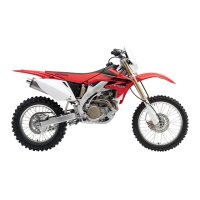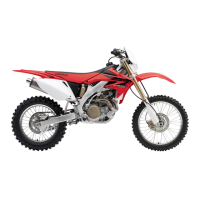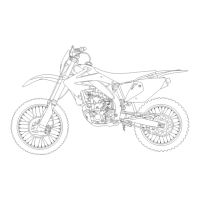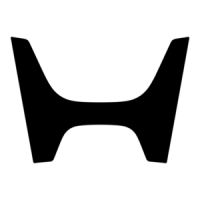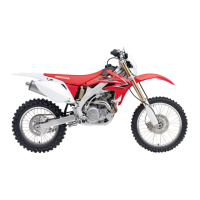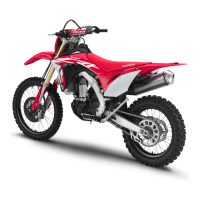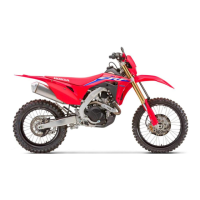
Do you have a question about the Honda CRF450X 2021 and is the answer not in the manual?
| Engine Type | 449cc liquid-cooled single-cylinder four-stroke |
|---|---|
| Bore x Stroke | 96.0mm x 62.1mm |
| Compression Ratio | 12.0:1 |
| Induction | Programmed Fuel Injection (PGM-FI), 46mm throttle body |
| Ignition | Full transistorized ignition |
| Rear Brake | Single 240mm disc |
| Front Tire | 80/100-21 |
| Rear Tire | 110/100-18 |
| Wheelbase | 58.3 inches |
| Final Drive | 520 chain; 13T/51T |
| Rear Suspension | Pro-Link Showa single shock with spring preload, rebound and compression damping adjustability; 12.3 inches travel |
| Front Brake | Single 240mm disc |
| Curb Weight | 275 pounds |
| Fuel Capacity | 2.0 gallons |
| Front Suspension | 49mm leading-axle inverted telescopic fork with rebound and compression damping adjustability; 12.0-inch travel |
Follow these guidelines to enhance your safety and riding pleasure.
Safety and information labels on your vehicle provide important safety information.
Make sure that you are wearing an approved helmet, eye protection, and other appropriate riding gear.
During the first operating day or 15 miles (25 km) of running, follow these guidelines.
We strongly advise that you do not add any accessories that were not specifically designed or approved for your vehicle.
We recommend that you do not carry any cargo on this motorcycle.
Identify the location of key parts on your vehicle.
Understand the vehicle's display, speedometer, and clock functions.
Learn the meaning of various indicator lamps on the instrument panel.
Locate and understand the function of the engine stop and start buttons.
Follow the procedures for starting the engine, including cold and warm starts.
Learn the 6-speed transmission pattern and how to shift gears.
Follow guidelines for refueling your vehicle safely and correctly.
Keeping your vehicle well-maintained is essential for safety and performance.
Details regular inspection and service intervals for off-road use.
Covers pre-ride inspections, between-motos checks, and general maintenance practices.
Instructions for removing and installing parts like the battery, seat, and side cover.
Diagnose and resolve issues when the engine fails to start.
Understand and address issues indicated by warning lights on the instrument panel.
Troubleshoot and resolve issues related to a depleted vehicle battery.
Procedure for replacing burned-out headlight and taillight bulbs.
Locate and replace blown fuses in the fuse box and main fuse.
Guidelines for cleaning, polishing, and maintaining your vehicle's appearance and condition.
Procedures for properly storing your vehicle for extended periods.
Recommendations and safety guidelines for transporting your vehicle on trailers.
Details on the vehicle's emission control systems and compliance requirements.
Information on warranty terms, coverage, and recommended service procedures.
Key physical measurements of the vehicle, including length, width, and wheelbase.
Technical details of the engine, such as bore, stroke, displacement, and valve clearance.
Details on frame type, recommended tires, and tire pressure.
Information on battery type, spark plugs, fuses, and lighting.
Required torque values for various bolts and fasteners during maintenance.

